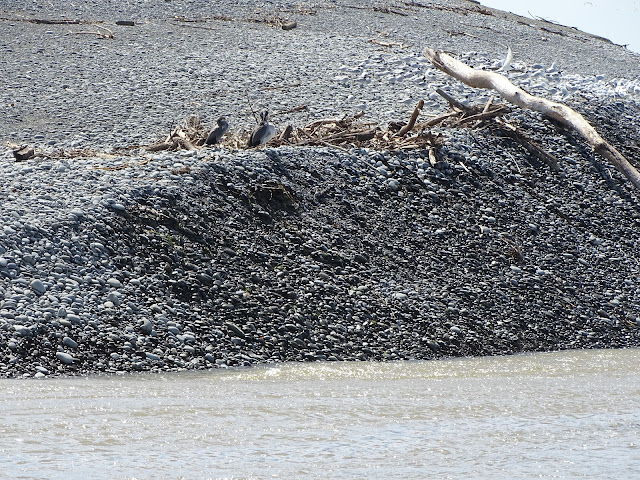Waihao Box is located east of Waimate, at the mouth of the Waihao River. There's a camping spot here where we stayed for a couple of nights.
You can see there's been a significant amount of rain in the previous few days.
There is no sand on the beach. Instead, large flat stones stretching into the distance . . .
. . . in both directions. It was like standing on a dune of shingle.
Nearby, the river mouth. On this side, a flock of terns sitting on the stones, and on the far side, you can see shags.
Here she is—waiting for me to come back.
On the first night, she found a friend—Mix. Mix loves to retrieve sticks and is very much at home in the water. This is about as deep as Lucy will go. She waited for Mix to bring the stick back in, but then she wouldn't let her bring it any further!
This is Mix's owner, Dave, on the right talking with Herman, another camper who arrived shortly after we did. Dave stays permanently in a caravan on a neighbouring farm. An interesting man—we enjoyed hearing about his life and the area.
There were a lot of shags around, and most of them weren't that frightened of us. Dave told us many of the juvenile shags were rather lethargic and had been dying, but he wasn't sure why.
There were a lot of shags around, and most of them weren't that frightened of us. Dave told us many of the juvenile shags were rather lethargic and had been dying, but he wasn't sure why.
A signs tells how the box was built in 1910, replacing a previous one built in 1896 about 2 kms further north. There is no permanent river mouth for the Waihao catchment. The box structure prevents the shingle barrier completely blocking the Waihao River, thus assisting with drainage and reducing the risk of flooding.
"Water can flow through the box, but what is especially ingenious about it is that the north-facing side of the box is open so that when flows are especially heavy, pressure builds up in the box so that water is then forced out the open side thus speeding up erosion of the gravels alongside it. These then scour away creating a channel from the lagoon to the sea. There's a 'nose' at the sea-side end that helps prevent the sea washing into the box (and thus stopping river water flowing out).
"It is believed that the Waihao Box is the only functioning one of its kind in New Zealand and possibly in the world. There were once two on Saltwater Creek near Timaru (one of which was still working until the 1970s) and one on Horseshoe Bend Creek (also in the Waimate District). Further afield there was thought to have once been a box on Lake Ellesmere near Christchurch and possibly two somewhere in the North Island."
(Source: http://www.scoop.co.nz/stories/AK1011/S00623/the-waihao-box-celebrates-centenary.htm - you can read more at this link.)
Where the river goes out to the sea (and Dave fishing).
Views of the box. Much of it is covered in shingle.
There are warnings about how the shingle moves and can be dangerous.
This shingle on the far side of the river mouth was falling away into the sea as I took this photo. Notice where the stones are slightly darker (freshly exposed to the sun, wet with water running through them). Although the shags appear unconcerned, I doubt it would be a good place to be standing for too much longer!
A monument was erected in 2010 to commemorate 100 years since the Box was built.
And a sombre reminder of how dangerous the moving gravel can be.
If you cannot see "Post a Comment" below, click here (and scroll down to the bottom of the post) to talk to me!
























No comments:
Post a Comment
Comments are very much appreciated. Thanks for taking the time to do so.